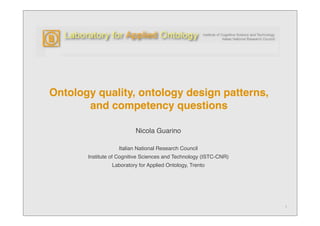
Ontology quality, ontology design patterns, and competency questions
- 1. Ontology quality, ontology design patterns, and competency questions Nicola Guarino Italian National Research Council Institute of Cognitive Sciences and Technology (ISTC-CNR) Laboratory for Applied Ontology, Trento 1
- 2. Good ontologies and bad ontologies 23
- 3. Conceptualization Perception Reality relevant invariants State of State of across presentation affairs Presentation Phenomena patterns: affairs patterns D, ℜ Ontological commitment K (selects D’⊂D and ℜ’⊂ℜ) Bad Language L Ontology Models MD’(L) Interpretations I ~Good Ontology Intended models for Ontology models each IK(L)
- 4. Ontology Quality: Precision and Correctness Good Less good High precision, max correctness Low precision, max correctness BAD WORSE Max precision, low correctness Low precision, low correctness 4
- 5. When precision is not enough Only one binary predicate in the language: on Only three blocks in the domain: a, b, c. Axioms (for all x,y,z): on(x,y) -> ¬on(y,x) on(x,y) -> ¬∃z (on(x,z) ∧ on(z,y)) All non-intended models (for the given domain) are excluded, but still some counterexamples can’t be excluded b c c c c a a a a a Excluded counterexamples Indistinguishable examples
- 6. A third dimension for ontology quality: accuracy • In general, a single intended model may not discriminate between positive and negative examples because of a mismatch between: • Cognitive domain and domain of discourse: lack of entities • Conceptual relations and ontology relations: lack of primitives • Capturing all intended models is not sufficient for a “perfect” ontology ! ! Precision: non-intended models are excluded ! ! Accuracy: negative examples are excluded 6
- 7. Correctness, precision, and accuracy • Correctness: no ontology constraint is wrong • Precision: the ontology discriminates between wrong and correct statements • Accuracy: the ontology discriminates between wrong and correct examples 7
- 8. Ontology design patterns and ontology quality “ontology design patterns play an important role in obtaining higher quality ontologies” (EKAW 2010 Ontology Quality Workshop CFP) 23
- 9. A critical tradeoff: reusability vs. interoperabilty • ontology patterns are supposed to be highly reusable... • Are they interoperable? • Differently from generic software, interoperability is the reason d’être of ontologies... 9
- 10. A content pattern1: Part-of • Name: part of • Intent: To represent entities and their parts • Competency questions: • What is this entity part of? • What are the parts of this entity? 1from www.ontologydesignpatterns.org 10
- 11. Member-collection • Competency questions: • What things are contained in this collection? • What collections this thing is member of? 11
- 12. Componency • Competency questions: • What is this object component of? • What are the components of this object? 12
- 13. An interpretation of “part-of”... or “component-of”? Dov Dory, Words from pictures for dual-channel processing, Communications of the ACM 51, 2008 13
- 14. Agent-Role • which agent does play this role? • what is the role that played by that agent? 14
- 15. Invoice 15
- 16. Some competency questions for the GoodRelations ontology • CQ1: Which retrievable Web Resources describe an offer? • CQ2: For which time frame is the offer valid? • CQ3: Which types of customers are eligible? • CQ4: Which are the eligible customer regions? • CQ5: Which shipping / delivery methods are available? • CQ6: Which methods of payment are accepted? • CQ10: What is the mail address and which are the contact details of the offering business entity? 16
- 17. Competency questions, according to their inventors (1) It is not a well-designed ontology if all competency questions have the form of simple lookup queries Uschold & Gruninger 96 17
- 18. Competency questions, according to their inventors (2) Kim, Fox & Gruninger 99 18
- 19. Original Gruninger’s competency questions • Planning and scheduling -- what sequence of activities must be completed to achieve some goal? At what times must these activities be initiated and terminated? • Temporal projection -- Given a set of actions that occur at different points in the future, what are the properties of resources and activities at arbitrary points in time? • Execution monitoring and external events -- What are the effects on the enterprise model of the occurrence of external and unexpected events (such as machine breakdown or the unavailability of resources)? • Hypothetical reasoning -- what will happen if we move one task ahead of schedule and another task behind schedule? What are the effects on orders if we buy another machine? 19
- 20. Competency questions revisited • Epistemological: • what is this entity part of? • what are the parts of this entity? • Ontological: • what does it mean to be a part of something? • can something be part of itself? • can something have only one (proper) part? • are two entities the same if they have the same parts? • does parthood imply contact? • what’s the difference between parthood and spatial inclusion? • what’s the difference between parts and components? • how are they related? 20
- 21. A simple methodology towards ontology quality 1. Isolate a target community 2. For each term to be used in the ontology, check its possible ambiguities within the target community (collecting examples and counterexamples) 3. Leveraging on axioms, and on the proper choice of domain and primitives 1. Account for the differences among different senses 2. Account for the relationships among different senses 4. Stop when all the terms used are unambiguous for the target community 21
- 22. Conclusions: the risks of (current) ODPs in the light of ontology quality • Underspecification: simplicity encourages reusability but risks to decrease interoperability • Isolation: focusing on an isolated pattern risks to overlook important structural connections 22
